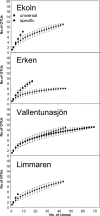Flavobacteria blooms in four eutrophic lakes: linking population dynamics of freshwater bacterioplankton to resource availability
- PMID: 17435002
- PMCID: PMC1932693
- DOI: 10.1128/AEM.02534-06
Flavobacteria blooms in four eutrophic lakes: linking population dynamics of freshwater bacterioplankton to resource availability
Abstract
Heterotrophic bacteria are major contributors to biogeochemical cycles and influence water quality. Still, the lack of representative isolates and the few quantitative surveys leave the ecological role and significance of single bacterial populations to be revealed. Here we analyzed the diversity and dynamics of freshwater Flavobacteria populations in four eutrophic temperate lakes. From each lake, clone libraries were constructed using primers specific for either the class Flavobacteria or Bacteria. Sequencing of 194 Flavobacteria clones from 8 libraries revealed a diverse freshwater Flavobacteria community and distinct differences among lakes. Abundance and seasonal dynamics of Flavobacteria were assessed by quantitative PCR with class-specific primers. In parallel, the dynamics of individual populations within the Flavobacteria community were assessed with terminal restriction fragment length polymorphism analysis using identical primers. The contribution of Flavobacteria to the total bacterioplankton community ranged from 0.4 to almost 100% (average, 24%). Blooms where Flavobacteria represented more than 30% of the bacterioplankton were observed at different times in the four lakes. In general, high proportions of Flavobacteria appeared during episodes of high bacterial production. Phylogenetic analyses combined with Flavobacteria community fingerprints suggested dominance of two Flavobacteria lineages. Both drastic alterations in total Flavobacteria and in community composition of this class significantly correlated with bacterial production, emphasizing that resource availability is an important driver of heterotrophic bacterial succession in eutrophic lakes.
Figures




References
-
- Abell, G. C. J., and J. P. Bowman. 2005. Colonization and community dynamics of class Flavobacteria on diatom detritus in experimental mesocosms based on Southern Ocean seawater. FEMS Microbiol. Ecol. 53:379-391. - PubMed
-
- Bernardet, J. F., P. Segers, M. Vancanneyt, F. Berthe, K. Kersters, and P. Vandamme. 1996. Cutting a Gordian knot: emended classification and description of the genus Flavobacterium, emended description of the family Flavobacteriaceae, and proposal of Flavobacterium hydatis nom. nov. (Basonym, Cytophaga aquatilis Strohl and Tait 1978). Int. J. Bacteriol. 46:128-148.
-
- Cole, J. J., G. E. Likens, and D. L. Strayer. 1982. Photosynthetically produced dissolved organic carbon: an important carbon source for planktonic bacteria. Limnol. Oceanogr. 27:1080-1090.
Publication types
MeSH terms
Substances
Associated data
- Actions
- Actions
- Actions
- Actions
- Actions
- Actions
- Actions
- Actions
- Actions
- Actions
- Actions
- Actions
- Actions
- Actions
- Actions
- Actions
- Actions
- Actions
- Actions
- Actions
- Actions
- Actions
- Actions
- Actions
- Actions
- Actions
- Actions
- Actions
- Actions
- Actions
- Actions
- Actions
- Actions
- Actions
- Actions
- Actions
- Actions
- Actions
- Actions
- Actions
- Actions
- Actions
- Actions
- Actions
- Actions
- Actions
- Actions
- Actions
- Actions
- Actions
- Actions
- Actions
- Actions
- Actions
- Actions
- Actions
- Actions
- Actions
- Actions
- Actions
- Actions
- Actions
- Actions
- Actions
- Actions
- Actions
- Actions
- Actions
- Actions
- Actions
- Actions
- Actions
- Actions
- Actions
- Actions
- Actions
- Actions
- Actions
- Actions
- Actions
- Actions
- Actions
- Actions
- Actions
- Actions
- Actions
- Actions
- Actions
- Actions
LinkOut - more resources
Full Text Sources
Molecular Biology Databases

